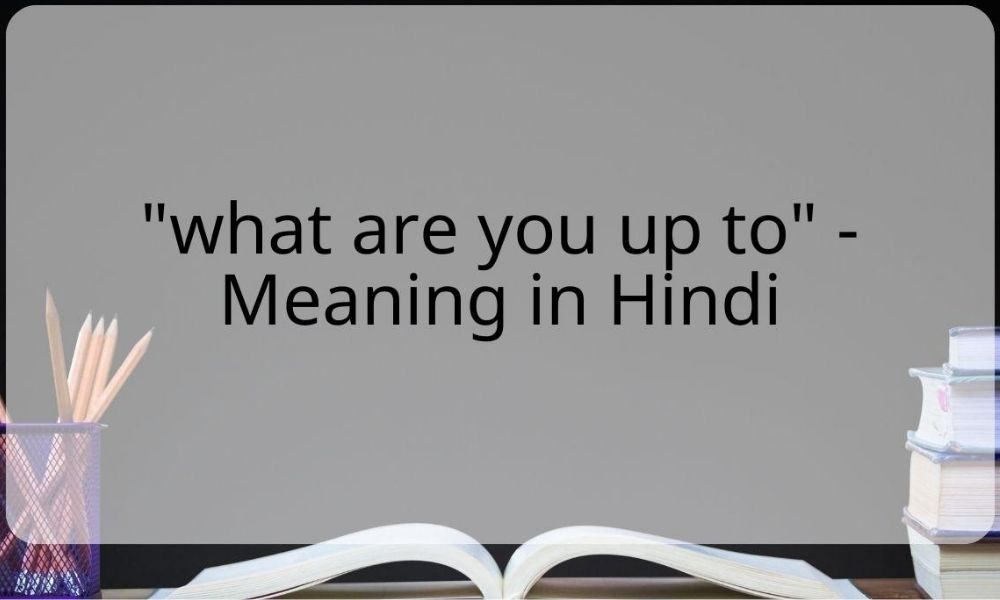Contents
What Does “What Are You Up To” Mean in Hindi?
When learning a new language, it’s essential to understand the meaning of common phrases and expressions. One such phrase that often comes up in conversations is “What are you up to?” This question is used to inquire about someone’s current activities or plans. In Hindi, the phrase “What are you up to?” can be translated as “तुम क्या कर रहे हो?” (tum kya kar rahe ho?). Let’s explore the meaning and usage of this phrase in more detail.
The Literal Translation
The phrase “तुम क्या कर रहे हो?” (tum kya kar rahe ho?) can be broken down into three parts:
- “तुम” (tum) – This is the informal second-person pronoun, equivalent to “you” in English.
- “क्या” (kya) – This is a question word that translates to “what” in English.
- “कर रहे हो?” (kar rahe ho?) – This is a combination of the verb “कर रहे” (kar rahe), which means “doing,” and the second-person present tense auxiliary verb “हो?” (ho?), which indicates a question.
So, when put together, the literal translation of “तुम क्या कर रहे हो?” (tum kya kar rahe ho?) is “What are you doing?”
Read:What are some benefits of maintaining mangrove forests?Usage and Context
The phrase “तुम क्या कर रहे हो?” (tum kya kar rahe ho?) is commonly used in informal conversations among friends, family members, or acquaintances. It serves as a way to inquire about someone’s current activities or plans. The question can be asked in various situations, such as when catching up with a friend, checking in on someone’s progress, or simply expressing curiosity about their day.
Here are a few examples of how the phrase can be used in different contexts:
- Example 1: आज शाम को तुम क्या कर रहे हो? (Aaj shaam ko tum kya kar rahe ho?) – What are you doing this evening?
- Example 2: तुम क्या कर रहे हो? कुछ खाने का मन है? (Tum kya kar rahe ho? Kuch khane ka man hai?) – What are you doing? Do you feel like eating something?
- Example 3: तुम क्या कर रहे हो? कहीं घूमने चलें? (Tum kya kar rahe ho? Kahi ghoomne chale?) – What are you doing? Shall we go somewhere for a walk?
As you can see from these examples, the phrase can be used to initiate a conversation or suggest an activity to do together.
Read:What happened to nsfw411?Common Responses
When someone asks you “तुम क्या कर रहे हो?” (tum kya kar rahe ho?), you can respond with various answers depending on your current situation. Here are some common responses:
- Response 1: मैं घर पर हूँ। (Main ghar par hoon.) – I am at home.
- Response 2: मैं काम कर रहा/रही हूँ। (Main kaam kar raha/rahi hoon.) – I am working.
- Response 3: मैं दोस्तों के साथ घूम रहा/रही हूँ। (Main doston ke saath ghoom raha/rahi hoon.) – I am hanging out with friends.
These responses provide a glimpse into your current activities and help continue the conversation.
Alternative Phrases
While “तुम क्या कर रहे हो?” (tum kya kar rahe ho?) is a common and widely understood phrase, there are alternative ways to ask the same question in Hindi. Here are a few examples:
- Alternative 1: तुम क्या कर रहे हो अभी? (Tum kya kar rahe ho abhi?) – What are you doing right now?
- Alternative 2: तुम अभी क्या कर रहे हो? (Tum abhi kya kar rahe ho?) – What are you doing at the moment?
- Alternative 3: तुम क्या कर रहे हो वर्तमान में? (Tum kya kar rahe ho vartaman mein?) – What are you doing currently?
These alternative phrases can be used interchangeably with the original phrase to convey the same meaning.
Read:What year would i be born if i was 14?Conclusion
In conclusion, the phrase “तुम क्या कर रहे हो?” (tum kya kar rahe ho?) in Hindi translates to “What are you doing?” in English. It is a common and informal way to inquire about someone’s current activities or plans. The phrase is used in various contexts, such as casual conversations among friends or family members. When asked this question, you can respond with different answers depending on your situation. Understanding and using this phrase will help you engage in meaningful conversations and connect with Hindi speakers on a deeper level.









